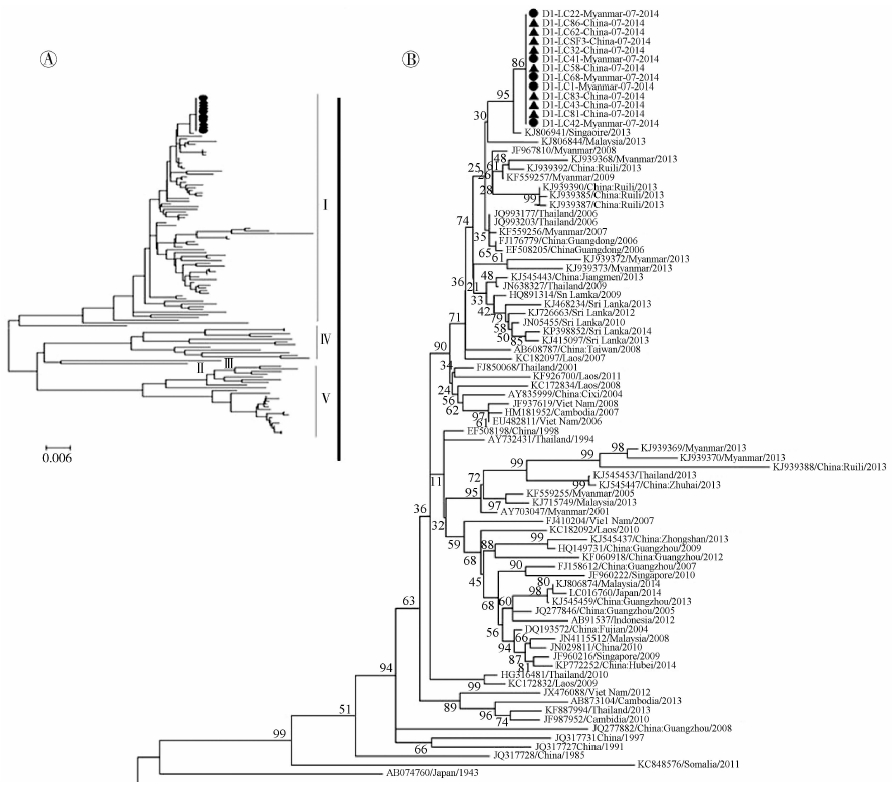文章信息
- 郭晓芳, 杨明东, 姜进勇, 李华昌, 朱崇革, 桂琴, 卜力群, 周红宁.
- Guo Xiaofang, Yang Mingdong, Jiang Jinyong, Li Huachang, Zhu Chongge, Gui Qin, Bu Liqun, Zhou Hongning.
- 云南省中缅边境2015年一起登革热暴发的分子特征分析
- Molecular characteristics of dengue virus outbreak in China-Myanmar border region, Yunnan province, 2015
- 中华流行病学杂志, 2016, 37(3): 398-401
- Chinese Journal of Epidemiology, 2016, 37(3): 398-401
- http://dx.doi.org/10.3760/cma.j.issn.0254-6450.2016.03.022
-
文章历史
- 收稿日期: 2015-08-25
2. 677000 临沧市疾病预防控制中心;
3. 677500 耿马县疾病预防控制中心
2. Lincang County Center for Disease Control and Prevention, Lincang 677000, China;
3. Gengma County Center for Disease Control and Prevention, Gengma 677500, China
登革热是由登革病毒(DENV)引起的急性蚊媒传染病,主要通过埃及伊蚊或白纹伊蚊叮咬传播,DENV有4个血清型:DENV-1、DENV-2、DENV-3、DENV-4[1]。基于DENV-1的E(Envelop)基因序列进化分析,又可将DENV-1分为Ⅰ、Ⅱ、Ⅲ、Ⅳ、Ⅴ共5个基因型[2]。2013年云南省景洪市、勐腊县和瑞丽市相继发生本地登革热暴发流行[3, 4, 5]。2015年云南省瑞丽市、景洪市及临沧市报道了登革热本地病例,其中临沧市耿马傣族佤族自治县(耿马县)孟定镇7月10日首次报道了登革热本地病例,为了明确此次暴发的病原,对疾病防控提供病原学证据,本研究对暴发早期流行的DENV进行分子特征分析。
对象与方法1. 研究对象:耿马县孟定镇于2015年7月10日报告了首例登革热本地病例,截止9月30日,共报告240例登革热病例,其中包括139例本地病例和101例输入病例。本次暴发疫情波及孟定镇城区、孟定农场、清水河口岸和5个行政村。选择暴发早期(7月10-17日)采集的39份DENV NS1抗原阳性血清标本,25份来自中国云南省耿马县孟定镇本地病例和14份来自缅甸输入病例。DENV NS1抗原诊断试剂盒为美国One Step Dengue NS1 RapiDipTM InstaTest (Serum)试剂盒(LOT:SE1104,EXP:2016/03)。标本采集后放-70 ℃保存。
2. DENV 特异核酸检测:用北京天恩泽基因科技有限公司生产的柱式病毒RNAout提取血清中的DENV RNA,参照文献[6]合成cDNA。DENV特异核酸检测(半巢式RT-PCR法)所用引物(通用引物和分型引物)及方法参照《登革热诊断标准(WS 216-2008)》[7],引物由北京六合华大基因科技有限公司合成。在试验过程中,均设有DENV阴性、阳性对照。
3. DENV E基因扩增及测序:对DENV特异核酸阳性标本,采用相应的DENV E基因引物进行扩增[8]。将扩增阳性的PCR产物送北京六合华大基因科技有限公司进行测序和序列拼接。对部分因血清中病毒核酸浓度低而扩增不出E基因片段的标本,将DENV特异分型引物PCR的阳性产物送测序。用Megalign分析所得序列核苷酸的相似性,并将所有测序结果在美国NCBI网站进行BLAST比对,以进一步验证病毒的血清型。
4. DENV分子特征:参照文献[2]在GenBank中选出不同国家、不同时期的 DENV E基因序列与本研究得到的DENV E基因序列,采用Mega 5.05软件进行E基因序列比对,并用邻接(NJ)法构建系统进化树,Bootstrap值设定为1 000。
结 果1. DENV特异核酸检测:共检测39份(包括25份本地和14份缅甸输入登革热病例)DENV NS1抗原阳性血清标本,31份为DENV-1阳性(包括21份本地和10份缅甸输入病例),8份为DENV阴性。用DENV-1 E基因特异引物对DENV-1阳性标本进行PCR扩增,将阳性PCR产物送测序,得到13条E基因1 485 bp序列(包括8份本地和5份缅甸输入),其核苷酸相似性均为100%。经BLAST比对,均与DENV-1基因Ⅰ型SG(EHI)D1/09717Y13(GenBank:KJ806941,该序列为 E基因序列)和 DV1-SL-2010b株(GenBank:JN054255,该序列为全基因组序列)的核苷酸相似性最高,分别为99.8%(1 482/1 485)和99.1%(1 472/1 485)。
选出12份因血清中病毒核酸浓度低而扩增不出E基因片段的标本和1份已经扩增出E基因序列标本的阳性分型PCR产物共计13份(9份本地和4份缅甸输入),PCR产物送测序,经序列剪切,每份得到DENV基因组中CprM(capsid pre-membrane)区406 bp的核苷酸序列,用MegAlign 分析,13株序列的核苷酸相似性均为100%。经BLAST比对,均与DENV-1基因Ⅰ型DV1-SL-2010b株的核苷酸相似性最高,为99.0%(402/406)。
2. DENV E基因系统进化分析:在GenBank中选出五大洲除中国外的21个国家1943-2014年鉴定的75条DENV-1 E基因序列、中国6省份(广东、福建、浙江、河南、湖北、台湾)1985-2014年的27株序列和云南省2013年10条DENV-1 E基因序列与本研究得到的13条DENV-1 E基因序列,采用Mega 5.05软件进行1 485 bp E基因序列比对,并用NJ法构建系统进化树。结果显示,共112株参考序列分别位于各自5个基因型的进化分支(图 1A);主要由包括中国在内的东南亚国家的DENV-1 E基因序列聚在一起形成了基因Ⅰ型进化分支,本研究得到的13株序列均位于基因Ⅰ型的单独进化分支(图 1B)。

|
| 注: “▲”为本地病例; “●”为缅甸输入病例; A:包括112株DENV-1 E基因参考序列和本研究的13株登革序列在内的系统进化树, 未显示序列标签; B:A图中基因Ⅰ型进化分支; 参考序列标签标记为GenBank号/国家:地区/年份 图 1 2015年云南省耿马县13株DENV-1 E基因序列系统进化分析(NJ法) |
2015年耿马县孟定镇发生登革热暴发疫情,对暴发早期的39份NS1阳性标本进行DENV 特异RT-PCR检测,共有31份标本为DENV-1。进化分析发现,本地病例和输入病例检测得到的13株E基因序列(包括8份本地和5份缅甸输入病例)均位于DENV-1基因Ⅰ型的单独进化分支;对于未得到E基因序列的12株CprM序列,经BLAST比对均与DENV-1基因Ⅰ型病毒株相似性最高,提示本次暴发主要由DENV-1基因Ⅰ型引起。
1975-1989年云南省南部和西部采集的白纹伊蚊中曾分离到6株DENV-4[9, 10, 11]。云南省从2001年开始出现散在输入性登革热病例以来,病例数逐年增多,至2008年首次在云南省中缅边境地区出现了本地感染病例,分别为潞西市4例、盈江县1例、陇川县1例;临沧市的镇康县5例[12]。因当时现场仅用DENV IgM抗体检测试剂盒筛检病例,采样标本中病毒核酸浓度极低,导致未能得到当年流行的DENV的毒株和核苷酸序列,亦不知流行的DENV血清型。同年,中国云南省瑞丽市边境地区发生输入性登革热暴发,并间接证实缅甸木姐市2008年存在DENV-1和DENV-3型病毒流行[13]。2013年8月,景洪市[3]、勐腊县发生了DENV-3的流行[4];9月,瑞丽市发生了DENV-1和DENV-2的混合暴发流行[5]。新得到的13株本地和缅甸输入的DENV-1 E基因序列均位于DENV-1基因Ⅰ型单独的进化分支,提示与其相邻缅甸地区区域流行的DENV进化关系最近;并且与近年中国的DENV-1病毒株特别是与相邻的瑞丽市2013年DENV-1病毒株(5株本地病例和5株缅甸输入病例)位于不同进化分支,提示2015年临沧市耿马县孟定镇流行的DENV不是来源于国内。临沧市于2004-2008年间,仅于2008年在镇康县发生了5例本地登革热病例[12],并且2009-2014年间仅报告1例输入病例[14]。综合分析可认为本次暴发疫情由来自相邻的缅甸登革热输入病例引起。
DENV-1是近年来在全球流行比较广泛血清型之一,其中的基因Ⅰ、Ⅳ和Ⅴ型的流行范围不断扩大[15]。既往研究显示,病毒加速传播造成了病毒基因的扩展,为其成功选择成为具有高水平流行潜力或毒力的变异株提供了大量机会[16]。与中国云南省接壤的缅甸[5]、老挝[6, 17]、越南[18]均有DENV-1的流行。据现有实验室监测资料显示,2013-2015年云南省瑞丽市登革热暴发主要由DENV-1基因Ⅰ型引起。本研究结果显示,耿马县孟定镇登革热暴发由DENV-1基因Ⅰ型引起,提示DENV-1在云南省的流行范围有扩大趋势,故当地需加强对登革热防控的综合措施,以防止登革热疫情的进一步扩散。
利益冲突 无| [1] 卫生部疾病预防控制局. 登革热防治手册[M]. 2版. 北京:人民卫生出版社,2008:1. Bureau of Disease Prevention and Control,Ministry of Health. The manual of dengue fever prevention and control[M]. 2nd ed. Beijing:People's Medical Publishing House,2008:1. |
| [2] Goncalvez AP,Escalante AA,Pujol FH,et al. Diversity and evolution of the envelope gene of dengue virus type 1[J]. Virology,2002,303(1):110-119. DOI:10.1006/viro.2002.1686. |
| [3] Guo XF,Yang HL,Wu C,et al. Molecular characterization and viral origin of the first dengue outbreak in Xishuangbanna,Yunnan province,China,2013[J]. Am J Trop Med Hyg,2015,93(2):390-393. DOI:10.4269/ajtmh.14-0044. |
| [4] 刘华兴,刘江云,鲁秀英,等. 云南西双版纳州勐腊县一起登革热暴发疫情调查分析[J]. 中国病原生物学杂志,2014,9(3):268-270. Liu HX,Liu JY,Lu XY,et al. Analysis and investigation of outbreaks of dengue fever in Mengla county,Xishuangban prefecture in Yunnan province[J]. J Path Biol,2014,9(3):268-270. |
| [5] Wang BH,Li YP,Feng Y,et al. Phylogenetic analysis of dengue virus reveals the high relatedness between imported and local strains during the 2013 dengue outbreak in Yunnan,China:a retrospective analysis[J]. BMC Infect Dis,2015,15:142. DOI:10.1186/s12879-015-0908-x. |
| [6] 郭晓芳,李鸿斌,卢云兰,等. 云南省输入性登革热病例登革病毒1型的分离研究[J]. 中国病原生物学杂志,2012,7(4):241-243. Guo XF,Li HB,Lu YL,et al. The first report of isolation of patients with imported dengue in Yunnan province[J]. J Path Biol,2012,7(4):241-243. |
| [7] 中华人民共和国卫生部. 登革热诊断标准 WS 216-2008[S]. 北京:中国标准出版社,2008. Ministry of Health,People's Republic of China. WS 216-2008 Diagnostic criteria and principle of management of dengue fever[S]. Beijing:China Standard Publishing House,2008. |
| [8] Lee KS,Lo S,Tan SS,et al. Dengue virus surveillance in Singapore reveals high viral diversity through multiple introductions and in situ evolution[J]. Infect Genet Evol,2012,12(1):77-85. DOI:10.1016/j.meegid.2011.10.012. |
| [9] 李雪东,罗惠容,刘丽华,等. 从捕自云南省河口县的白纹伊蚊分离得到4型登革病毒[J]. 病毒学杂志,1987,2(1):76-77. Li XD,Luo HR,Liu LH,et al. A strain of dengue virus type 4 isolated from Aedes albopictus captured in Hekou county of Yunnnan province in 1975[J]. Virolog Sin,1987,2(1):76-77. |
| [10] 张海林,自登云,龚正达. 云南省登革热流行病学调查分析[J]. 地方病通报,1999,14(3):50-54. DOI:10.3969/j.issn.1000-3711. 1999.03.016. Zhang HL,Zi DY,Gong ZD. The epidemiological survey of dengue fever in Yunnan province,China[J]. End Dis Bull,1999,14(3):50-54. DOI:10.3969/j.issn.1000-3711.1999.03.016. |
| [11] 王静林,张海林,孙肖红,等. 云南登革4型病毒的鉴定及NS1和NS2a基因序列分析[J]. 中国人兽共患病学报,2008,24(7):636-640. DOI:10.3969/j.issn.1002-2694.2008.07.010. Wang JL,Zhang HL,Sun XH,et al. Identification and sequence analysis of NS1 and NS2a of two strains of dengue type-4 virus from mosquitoes in Yunnan province[J]. Chin J Zoon,2008,24(7):636-640. DOI:10.3969/j.issn.1002-2694.2008.07.010. |
| [12] 李华宪,周红宁,杨沅川,等. 2004-2008年云南省登革热流行现状[J]. 中国媒介生物学及控制杂志,2010,21(6):576-580. Li HX,Zhou HN,Yang YC,et al. Dengue fever epidemic situation in Yunnan province from 2004 to 2008[J]. Chin J Vector Biol Control,2010,21(6):576-580. |
| [13] 张海林,付士红,邓掌,等. 云南中缅边境一起输入性登革热暴发的分子流行病学研究[J]. 中华流行病学杂志,2013,34(5):428-432. DOI:10.3760/cma.j.issn.0254-6450.2013.05.004. Zhang HL,Fu SH,Deng Z,et al. An outbreak of imported dengue fever from Myanmar to the border of China,with its viral molecular epidemiological features[J]. Chin J Epidemiol,2013,34(5):428-432. DOI:10.3760/cma.j.issn.0254-6450.2013.05. 004. |
| [14] 杨明东,姜进勇,郭晓芳,等. 2004-2008年云南省登革热流行病学调查与分析[J]. 中国病原生物学杂志,2015,10(8):738-742. DOI:10.13350/j.cjpb.150816. Yang MD,Jiang JY,Guo XF,et al. Epidemiological and investigaton of dengue fever in Yunnnan province from 2009 to 2014[J]. J Path Biol,2015,10(8):738-742. DOI:10.13350/j.cjpb.150816. |
| [15] Villabona-Arenas CJ,de Andrade Zanotto PM. Worldwide spread of dengue virus type 1[J]. PLoS One,2013,8(5):e62649. DOI:10.1371/journal.pone.0062649. |
| [16] Ng LC. Challenges in dengue surveillance and control[J]. Western Pac Surveill Response J,2011,2(2):1-3. DOI:10.5365/WPSAR.2011.2.2.001. |
| [17] Dubot-Pérès A,Vongphrachanh P,Denny J,et al. An epidemic of dengue-1 in a remote village in rural Laos[J]. PLoS Negl Trop Dis,2013,7(8):e2360. DOI:10.1371/journal.pntd.0002360. |
| [18] Fox A,Le NM,Simmons CP,et al. Immunological and viral determinants of dengue severity in hospitalized adults in Ha Noi,Viet Nam[J]. PLoS Negl Trop Dis,2011,5(3):e967. DOI:10.1371/journal.pntd.0000967. |
 2016, Vol. 37
2016, Vol. 37


